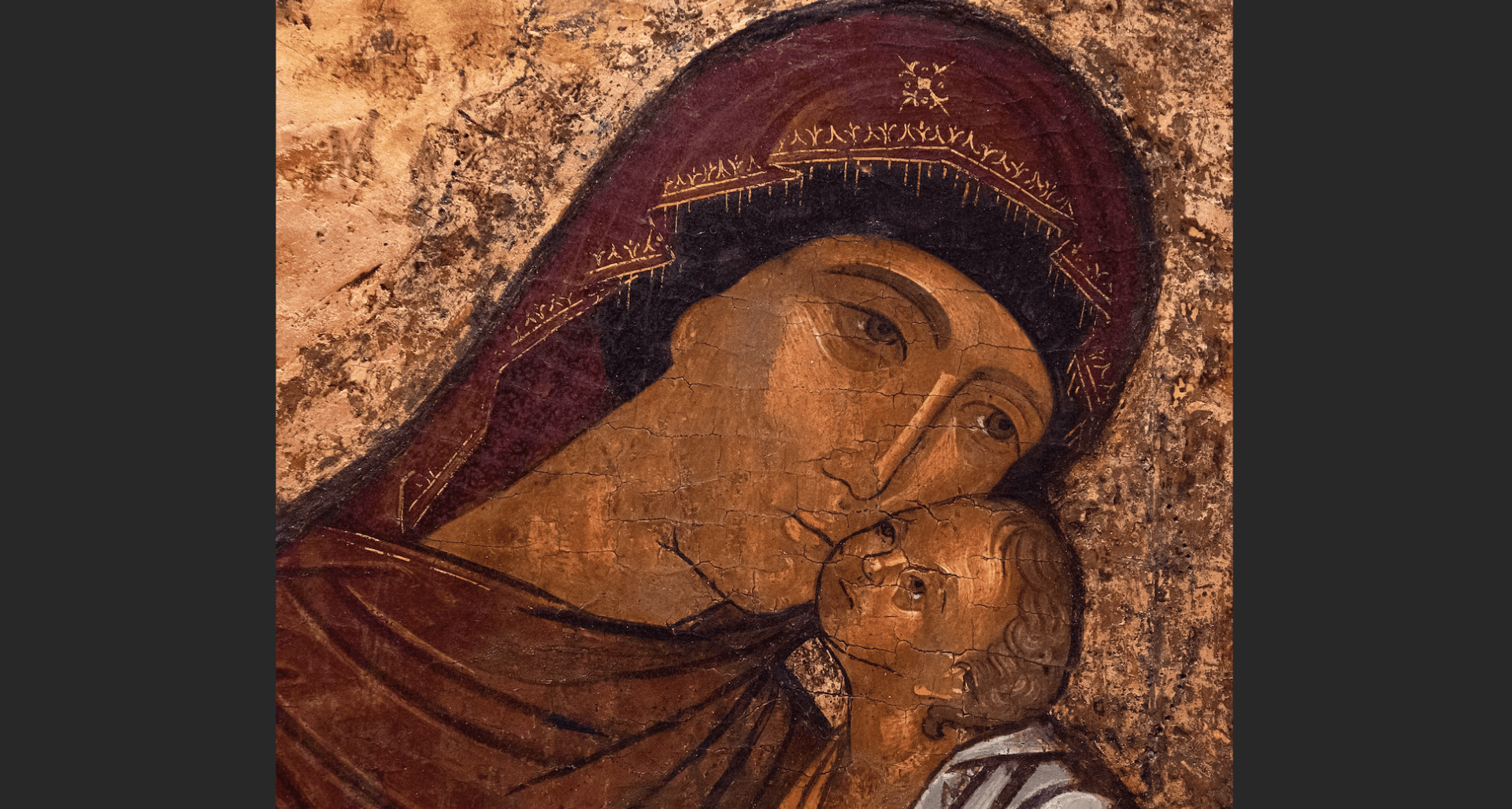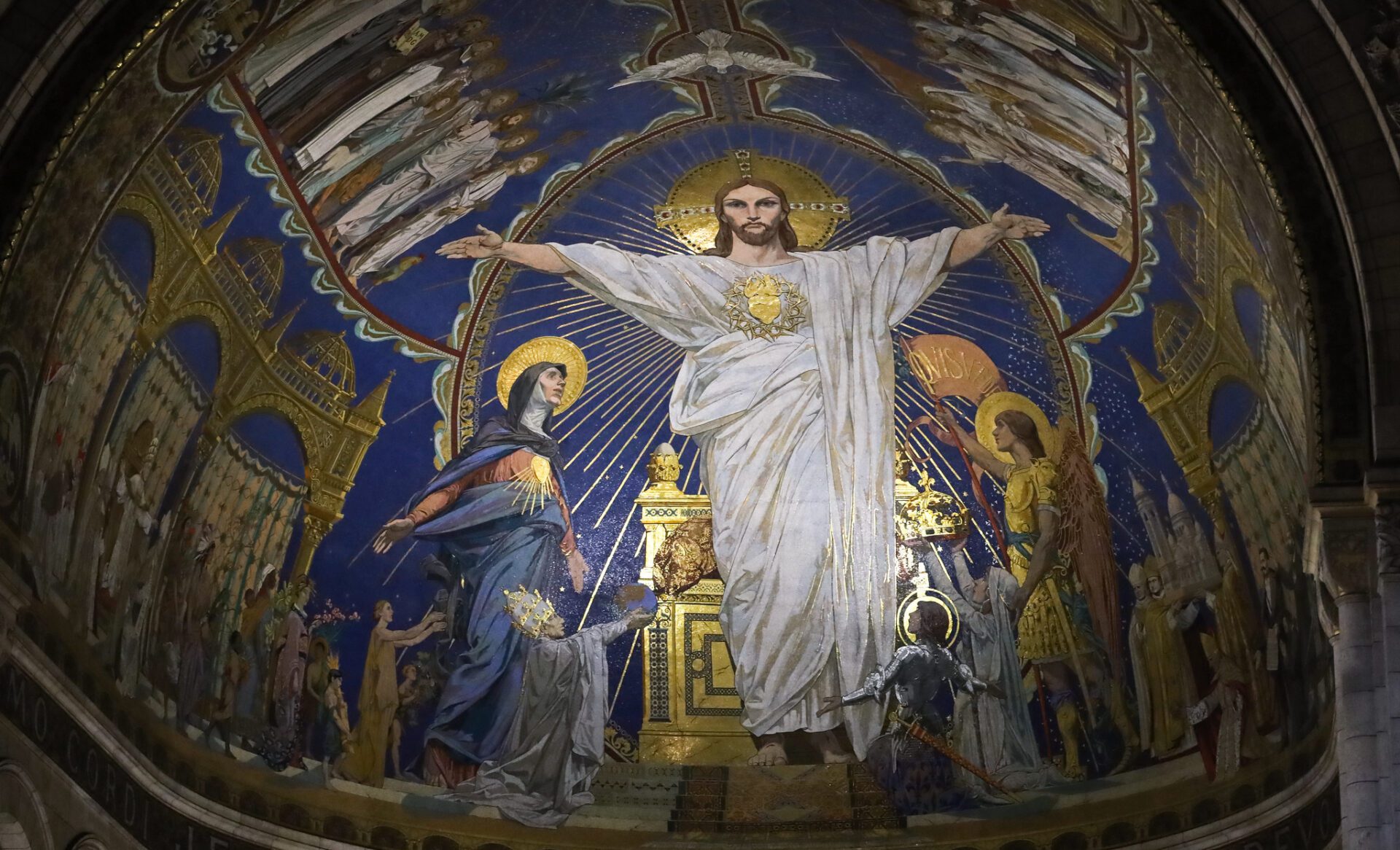
After three conferences which have studied the theme of “The Virgin Mary in the Liturgy” from the scriptural, iconographic, and sacramental point of view [see editor’s note, above], now let’s try to ponder it from the theology of the liturgy. By way of introduction, two questions can take us to the threshold of the mystery we wish to contemplate. The first concerns the name which the Apostolic Tradition chooses to precisely situate Mary in the economy of salvation. The second concerns the liturgy as a privileged place of our awareness of the role of Mary in this economy and in Christian life.
How Should We Call You, Mary?1
“For your Mother, Lord, no man knows what name to use,” exclaims St. Ephrem at the beginning of a hymn about the Nativity.2 The story of the Annunciation already suggests this perplexity. The first word of the angel Gabriel is, “Rejoice, full of grace,” (Luke 1:28) and only after the silence of the Virgin of Nazareth does he pronounce her name: “Do not be afraid, Mary” (Luke 1:30). By her family she is called Mary, but in the heart of God she is known, more profoundly, as “full of grace.” Hence, in the early tradition, her title of “Holy Mary” will become the All-Holy, Panaghia.3
Nevertheless, there is another title that appears in Christian prayer, long before the Nestorian crisis and the Council of Ephesus: “Mother of God,” Théotokos.4 We encounter it in Origen and in the better part of the Fathers of the fourth century. “The oldest Greek Marian antiphon”5 is remembered, since it lasts to this day in the Coptic, Byzantine, and Latin traditions: “Under the protection of your mercy, we take refuge, oh Mother of God: despise not our petitions, but free us from danger, you the only pure and blessed.” We understand that John of Antioch was able to remind Nestorius of Constantinople that the word théotokos had been “composed, written and pronounced by numerous Fathers.” We find, among others, the testimony of St. Gregory of Nazianzus: “If anyone does not believe that Holy Mary is the Mother of God, he is severed from the Godhead.”6 Finally, let us point out St. John Damascene’s profession of faith, which summarizes the patristic tradition and will guide our reflection: “With a just and true title, we call Holy Mary, Mother of God, as this name contains all the mystery of the Economy.”7
“Holy Mary, Mother of God” is the common and fundamental expression of the Apostolic Churches in their liturgies and their theological writings. Even when in the West, after the Latin Church had lost contact with the Churches of the East, and a certain popular piety privileged the names of “Holy Virgin Mary” or “Our Lady,” the second part of the Hail Mary continues to start precisely with “Holy Mary, Mother of God.”
The Liturgy as a Theological Place
If “the name of the Théotokos contains all the mystery of the Economy” of the Incarnate Word, from where can our essential knowledge come, our spiritual understanding of this mystery? The exegetes and the dogmatics without a doubt play a role in the Church, but for the faithful, it is in the liturgy that the doors of the Kingdom open, on the condition that our celebrations are, truthfully, signs of the mystery and alive through the effective participation of the assembly.
In this synergy of the Holy Spirit and the assembly, the liturgy is revealed as an amazing pedagogy. We listen to the Incarnate Word speak our human language; we contemplate his Economy in the holy icons which illuminate and confirm his Word; (cf. Nicaea II) we sing his “Design of Goodness” (Ephesians 1:9) in the hymns (madraché, troparios) or in the homilies in verse; (memré, kondakia) our faith “acts” (the liturgy is action) through the different symbols that weave our celebrations. It is necessary to experience the convergence of these four symbolic rays, whose light reflects the mystery celebrated and that constitute the living liturgy, to understand from where the theology of the liturgy comes: not a discourse about the liturgy, but the theology, the living knowledge of the true God, (John 17:3) delicious Wisdom that is given to us in the liturgy to be lived. It is in the liturgy that theology is the reflection in us of the mystery of the Economy: the understanding of faith reflects, like a mirror, the Glory of the Lord (2 Corinthians 3:8).
These fundamental notes are not of value only for the theology of the liturgy in general, but particularly concern the Holy Mother of God in the mystery of the Economy. In effect, because the earthly liturgy is sacramental, its language is essentially symbolic, for at least three reasons. First, liturgical expression is above all poetic, in the strong sense of a creative ascent of the real through its appearances. Later, because the symbols are accessible to all the faithful and awaken faith in all the fibers of man. Finally, because the liturgical symbolism manifests the mystery of the Incarnate Word who, in his humanity is the primordial Sacrament. However, we are going to show that this advent of the mystery is constantly bound to Mary, Mother of God. Because of that, the Théotokos escapes the scrutinizing and reducing discourses of philosophy (cf. the Syrian Fathers). We intuit that the same should occur concerning the Church, on the part of all the social sciences.
This awareness of the liturgy as a theological place should entail certain reflections on life. In regard to our theme, one of the tasks of the Institute of Liturgy is the formation of liturgists, of pastors who will be able to nurture the “Marian piety” of the faithful, guiding it in the true faith and, at times, purifying and correcting it. However, one of the causes of the fragility of popular Marian devotion comes from the fact that pastors do not sufficiently root the relationship with Mary in the sacramental economy: they point out certain scriptural facts and pass on to personal devotion. Perhaps the first cause of this omission can be found in the way in which Mariology is taught in the seminary: passing from Scripture to speculative theology. In both cases, the passage through the liturgy is omitted. However, the mystery of the Economy only becomes theology, life, and understanding in the Holy Spirit, through its sacramental actualization. From here proceed the two stages of our reflection: The Holy Mother of God in the sacramental economy and in the Christian life.
About This Piece:
Jean Corbon “Sainte Marie Mère de Dieu dans l’économie sacramentelle et dans la vie chrétienne:” Proche-Oriente Chrétien 45 (1995) 10-25. Conference given in the Institute of Liturgy of the University of the Holy Spirit in Kalik (Lebanon), March 14, 1994, in the liturgical conferences organized each year since 1985 by the Institute. The Arabic text is included in the ninth series of the liturgical conferences. Translated by Lucy Schemel from the Spanish as printed in Liturgia y Oracion, Jean Corbon, Ediciones Cristiandad S.A,, Madrid, 2004, pp. 91-115.
Image Source: AB/Theotokos according to the template of Angelos Akotantos, Wikimedia.
Footnotes
- This is the title proposed by Father Sebastian Brock in his introduction to the 11th hymn of St. Ephrem on the Nativity in L’oeil de lumieré, “Spiritualité orientale” no. 50 (Abbaye de Bellafontaine 1991) p. 241.
- Cf. previous note, p. 243, poem translated from the Syriac by Didier Rance.
- Since the fourth century, churches dedicated to her have carried the name of “Saint Mary” followed by the name of the place. Since this question closely concerns the place where the journal Proche-Orient Chrétien is published, we will be interested to reread the article appearing in no. 31 (1981) pp. 23-42: “Sainte Marie de la Probatique,” by M.J. Pierre and J.M Rousée, especially pp. 40-41.
- The dates in this paragraph are taken from P.Th. Caelot, Éphése et Chalcédonie, ed. de l’Orante (Paris 1967) pp. 13-14.
- Title of the article by P.F. Mercenier in Le Museon 52 (1939) 229-253. Cf. Sub tuum praesidium confugimus, sancta Dei Genitrix…
- “To Cledonius the Priest Against Apollinarius,” (Ep. CI.) CHURCH FATHERS: Letters, Division I (Gregory Nazianzen) (newadvent.org)
- De fide ortodoxa, III, 12.



